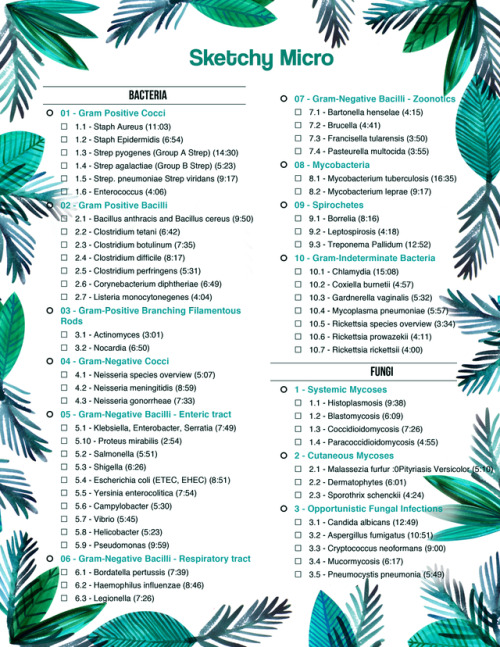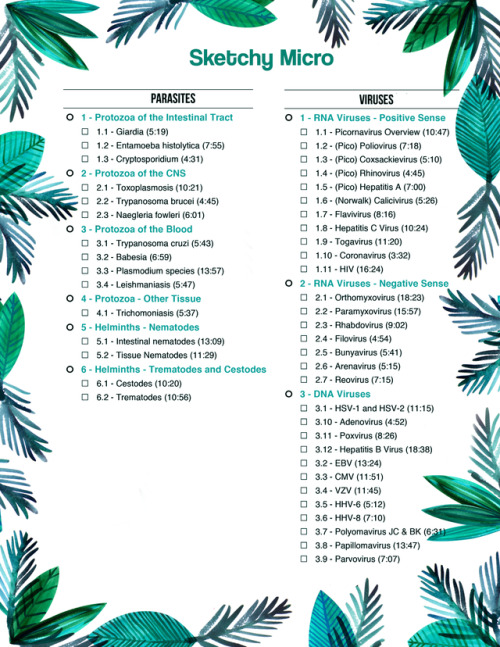More Mixed Mnemonics






More mixed mnemonics
More Posts from T-b-a-blr-blog and Others

(Day 4/100 days of productivity) - Haemophilus Influenzae card!
Today was mostly spent working on research, textbooks, but and making flashcards like this for microbiology!

Live, attenuated Vaccines Available in the US
Live vaccines induce HUMORAL & CELL-MEDIATED immunity
MRS. V.Z. FYI MAP

M umps / M easles
R ubella
S mallpox
.
V aricella Z oster
.
F rancisella tularensis
Y ellow Fever
In fluenza (intranasal)
.
M icobaterium bovis (BCG)
A denovirus
P olio (sabin)
Mechanism of Fever

study tip request: studying on public transport (or sth related like how to know what to record when you record yourself saying notes so that you can listen to them on public transport)
Best Way to Make Study Recordings for Yourself
Testing yourself is the most effective way to learn a topic, so this one is fairly straightforward. For recording:
Formulate an examination style question, and run through the answer in your head, organising your thoughts.
Then record the question, and mouth silently the answer fluently (reason being that just thinking in your head may result in too little or too much silence.
Leave a few extra seconds of silence for thinking time (~3-5 seconds).
Answer the question aloud in the recording (I’d suggest a brief one)
Rinse and repeat until you have enough to last you the whole commute.
Hope that helps! For more tips on how to spend time on commutes, check out my post on Staying Productive No Matter How Much Time You Have :)

Cysteine Growth Requirements
MICROBIOLOGY MNEMONIC
BoyFriend Lost Penis
B rucella
F rancisella
L egionella
P asteurella
or….
The four sisters “Ella” worship in the “cystein” chapel
Brucella
Francisella
Legionella
Pasteurella
Antibodies (Human)

The ‘foot’ (bottom) of the antibody is known as the Fc fragment - binds to cells, binds to complement = effector function (kills or removes antigen)
The top (antigen binding) is the Fab fragment
Chains are held together with disulphide binds
Associated molecules allow intracellular signalling
Normally 3X constant heavy chain domains per chain and a hinge region (except μ and ε which have 4 and no hinge region)
Classes of Immunoglobulins
The five primary classes of immunoglobulins are IgG, IgM, IgA, IgD and IgE, distinguished by the type of heavy chain found in the molecule.
IgG - gamma-chains
IgMs - mu-chains
IgAs - alpha-chains
IgEs - epsilon-chains
IgDs - delta-chains.
Differences in heavy chain polypeptides allow different types of immune responses. The differences are found primarily in the Fc fragment. There are only two main types of light chains: kappa (κ) and lambda (λ), and any antibody can have any combination of these 2 (variation).
IgG
monomer
Gamma chains
70-85% of Ig in human serum.
secondary immune response
only class that can cross the placenta - protection of the newborn during first 6 months of life
principle antibody used in immunological research and clinical diagnostics
21 day half life
Hinge region (allows it to make Y and T shapes - increasing chance of being able to bind to more than one site)
Fc strongly binds to Fcγ receptor on phagocyte - opsono-phagocytosis
Activates complement pathway

IgM
Serum = pentamer
Primary immune responses - first Ig to be synthesised
complement fixing
10% of serum Ig
also expressed on the plasma membrane of B lymphocytes as a monomer - B cell antigen receptor
H chains each contain an additional hydrophobic domain for anchoring in the membrane
Monomers are bound together by disulfide bonds and a joining (J) chain.
Each of the five monomers = two light chains (either kappa or lambda) and two mu heavy chains.
heavy chain = one variable and four constant regions (no hinge region)
can cause cell agglutination as a result of recognition of epitopes on invading microorganisms. This antibody-antigen immune complex is then destroyed by complement fixation or receptor mediated endocytosis by macrophages.
In humans there are four subclasses of IgG: IgG1, IgG2, IgG3 and IgG4. IgG1 and IgG3 activate complement.

IgD
B cell receptor
<1% of blood serum Ig
has tail pieces that anchor it across B cell membrane
forms an antigen specific receptor on mature B cells - consequently has no known effector function (don’t kill antigens, purely a receptor) (IgM as a monomer can also do this)

IgE
Extra rigid central domain
has the most carbohydrates
IgE primarily defends against parasitic invasion and is responsible for allergic reactions.
basophils and tissue mast cells express very high affinity Fc receptors for IgE - mast cells then release histamine
so high that almost all IgE is bound
sensitizes (activates) mucosal cells and tissues
protects against helminth parasites
IgE’s main purpose is to protect against parasites but due to improved sanitation these are no longer a prevalent issue across most of the world. Consequently it is thought that they become over activated and over sensitive while looking for parasites and start reacting to eg pollen and causing allergies.

IgA
Exists in serum in both monomeric (IgA1) and dimeric (IgA2) forms (dimeric when 2 Fcs bind via secretory complex)
15% of the total serum Ig.
4-7 day half life
Secretory IgA2 (dimer) = primary defense against some local infections
Secreted as a dimer in mucous (e.g., saliva, tears)
prevents passage of foreign substances into the circulatory system


Isotype: class of antibody (IgD, IgM etc)
Allotype: person specific alleles
Idiotype: (hyper) variable region - antibody specificity


Sketchy Micro To Do List:
• 01 - Gram Positive Cocci o 1.1 - Staph Aureus (11:03) o 1.2 - Staph Epidermidis (6:54) o 1.3 - Strep pyogenes (Group A Strep) (14:30) o 1.4 - Strep agalactiae (Group B Strep) (5:23) o 1.5 - Strep. pneumoniae Strep viridans (9:17) o 1.6 - Enterococcus (4:06) • 02 - Gram Positive Bacilli o 2.1 - Bacillus anthracis and Bacillus cereus (9:50) o 2.2 - Clostridium tetani (6:42) o 2.3 - Clostridium botulinum (7:35) o 2.4 - Clostridium difficile (8:17) o 2.5 - Clostridium perfringens (5:31) o 2.6 - Corynebacterium diphtheriae (6:49) o 2.7 - Listeria monocytonegenes (4:04) • 03 - Gram-Positive Branching Filamentous Rods o 3.1 - Actinomyces (3:01) o 3.2 - Nocardia (6:50) • 04 - Gram-Negative Cocci o 4.1 - Neisseria species overview (5:07) o 4.2 - Neisseria meningitidis (8:59) o 4.3 - Neisseria gonorrheae (7:33) • 05 - Gram-Negative Bacilli - Enteric tract o 5.1 - Klebsiella, Enterobacter, Serratia (7:49) o 5.10 - Proteus mirabilis (2:54) o 5.2 - Salmonella (5:51) o 5.3 - Shigella (6:26) o 5.4 - Escherichia coli (ETEC, EHEC) (8:51) o 5.5 - Yersinia enterocolitica (7:54) o 5.6 - Campylobacter (5:30) o 5.7 - Vibrio (5:45) o 5.8 - Helicobacter (5:23) o 5.9 - Pseudomonas (9:59) • 06 - Gram-Negative Bacilli - Respiratory tract o 6.1 - Bordatella pertussis (7:39) o 6.2 - Haemophilus influenzae (8:46) o 6.3 - Legionella (7:26)
• 07 - Gram-Negative Bacilli - Zoonotics o 7.1 - Bartonella henselae (4:15) o 7.2 - Brucella (4:41) o 7.3 - Francisella tularensis (3:50) o 7.4 - Pasteurella multocida (3:55) • 08 - Mycobacteria o 8.1 - Mycobacterium tuberculosis (16:35) o 8.2 - Mycobacterium leprae (9:17) • 09 - Spirochetes o 9.1 - Borrelia (8:16) o 9.2 - Leptospirosis (4:18) o 9.3 - Treponema Pallidum (12:52) • 10 - Gram-Indeterminate Bacteria o 10.1 - Chlamydia (15:08) o 10.2 - Coxiella burnetii (4:57) o 10.3 - Gardnerella vaginalis (5:32) o 10.4 - Mycoplasma pneumoniae (5:57) o 10.5 - Rickettsia species overview (3:34) o 10.6 - Rickettsia prowazekii (4:11) o 10.7 - Rickettsia rickettsii (4:00) • Fungi • 1 - Systemic Mycoses o 1.1 - Histoplasmosis (9:38) o 1.2 - Blastomycosis (6:09) o 1.3 - Coccidioidomycosis (7:26) o 1.4 - Paracoccidioidomycosis (4:55) • 2 - Cutaneous Mycoses o 2.1 - Malassezia furfur :0Pityriasis Versicolor (5:10) o 2.2 - Dermatophytes (6:01) o 2.3 - Sporothrix schenckii (4:24) • 3 - Opportunistic Fungal Infections o 3.1 - Candida albicans (12:49) o 3.2 - Aspergillus fumigatus (10:51) o 3.3 - Cryptococcus neoformans (9:00) o 3.4 - Mucormycosis (6:17) o 3.5 - Pneumocystis pneumonia (5:49)
• Parasites • 1 - Protozoa of the Intestinal Tract o 1.1 - Giardia (5:19) o 1.2 - Entamoeba histolytica (7:55) o 1.3 - Cryptosporidium (4:31) • 2 - Protozoa of the CNS o 2.1 - Toxoplasmosis (10:21) o 2.2 - Trypanosoma brucei (4:45) o 2.3 - Naegleria fowleri (6:01) • 3 - Protozoa of the Blood o 3.1 - Trypanosoma cruzi (5:43) o 3.2 - Babesia (6:59) o 3.3 - Plasmodium species (13:57) o 3.4 - Leishmaniasis (5:47) • 4 - Protozoa - Other Tissue o 4.1 - Trichomoniasis (5:37) • 5 - Helminths - Nematodes o 5.1 - Intestinal nematodes (13:09) o 5.2 - Tissue Nematodes (11:29) • 6 - Helminths - Trematodes and Cestodes o 6.1 - Cestodes (10:20) o 6.2 - Trematodes (10:56)
• Viruses • 1 - RNA Viruses - Positive Sense o 1.1 - Picornavirus Overview (10:47) o 1.2 - (Pico) Poliovirus (7:18) o 1.3 - (Pico) Coxsackievirus (5:10) o 1.4 - (Pico) Rhinovirus (4:45) o 1.5 - (Pico) Hepatitis A (7:00) o 1.6 - (Norwalk) Calicivirus (5:26) o 1.7 - Flavivirus (8:16) o 1.8 - Hepatitis C Virus (10:24) o 1.9 - Togavirus (11:20) o 1.10 - Coronavirus (3:32) o 1.11 - HIV (16:24) • 2 - RNA Viruses - Negative Sense o 2.1 - Orthomyxovirus (18:23) o 2.2 - Paramyxovirus (15:57) o 2.3 - Rhabdovirus (9:02) o 2.4 - Filovirus (4:54) o 2.5 - Bunyavirus (5:41) o 2.6 - Arenavirus (5:15) o 2.7 - Reovirus (7:15) • 3 - DNA Viruses o 3.1 - HSV-1 and HSV-2 (11:15) o 3.10 - Adenovirus (4:52) o 3.11 - Poxvirus (8:26) o 3.12 - Hepatitis B Virus (18:38) o 3.2 - EBV (13:24) o 3.3 - CMV (11:51) o 3.4 - VZV (11:45) o 3.5 - HHV-6 (5:12) o 3.6 - HHV-8 (7:10) o 3.7 - Polyomavirus JC & BK (6:31) o 3.8 - Papillomavirus (13:47) o 3.9 - Parvovirus (7:07)
Tularemia as a biological weapon
It was viewed as an attractive agent because:
it is easy to aerosolize,
it is highly infective; 10-50 bacteria are required to infect,
it is nonpersistent and easy to decontaminate (unlike anthrax),
it is highly incapacitating to infected persons,
it has comparatively low lethality, which is useful where enemy soldiers are in proximity to noncombatants, e.g. civilians
can you see the irony……we are working our ass off to kill these bugs.At th same time some weirdo working in one lab is making bio weapon.

Parasitology
-
 gprswa liked this · 1 year ago
gprswa liked this · 1 year ago -
 burningturtleathletestudent-blog liked this · 3 years ago
burningturtleathletestudent-blog liked this · 3 years ago -
 ryuk10101010101 liked this · 3 years ago
ryuk10101010101 liked this · 3 years ago -
 hygeiastudyfluryblr reblogged this · 3 years ago
hygeiastudyfluryblr reblogged this · 3 years ago -
 aram-arvin liked this · 4 years ago
aram-arvin liked this · 4 years ago -
 paureus reblogged this · 5 years ago
paureus reblogged this · 5 years ago -
 devinfreetime liked this · 5 years ago
devinfreetime liked this · 5 years ago -
 abitofatrainwreck liked this · 5 years ago
abitofatrainwreck liked this · 5 years ago -
 shygirl-inyourclass-blog reblogged this · 5 years ago
shygirl-inyourclass-blog reblogged this · 5 years ago -
 nabed20-blog reblogged this · 6 years ago
nabed20-blog reblogged this · 6 years ago -
 nabed20-blog liked this · 6 years ago
nabed20-blog liked this · 6 years ago -
 doctornimsblog liked this · 6 years ago
doctornimsblog liked this · 6 years ago -
 craftybanditexpertgiant liked this · 6 years ago
craftybanditexpertgiant liked this · 6 years ago -
 bajiraokaushal-blog liked this · 6 years ago
bajiraokaushal-blog liked this · 6 years ago -
 t-b-a-blr-blog reblogged this · 6 years ago
t-b-a-blr-blog reblogged this · 6 years ago -
 t-b-a-blr-blog liked this · 6 years ago
t-b-a-blr-blog liked this · 6 years ago -
 medicokrish-blog liked this · 7 years ago
medicokrish-blog liked this · 7 years ago -
 vachonski-blog liked this · 7 years ago
vachonski-blog liked this · 7 years ago -
 aathsh-blog liked this · 7 years ago
aathsh-blog liked this · 7 years ago -
 mrsbrown1217 liked this · 7 years ago
mrsbrown1217 liked this · 7 years ago -
 learninglifestuffsworld-blog liked this · 7 years ago
learninglifestuffsworld-blog liked this · 7 years ago -
 nkpandey1990-blog liked this · 7 years ago
nkpandey1990-blog liked this · 7 years ago -
 vitriolveins liked this · 7 years ago
vitriolveins liked this · 7 years ago -
 ahlamesef liked this · 8 years ago
ahlamesef liked this · 8 years ago -
 saretta0017-blog liked this · 8 years ago
saretta0017-blog liked this · 8 years ago -
 zhuykay-blog reblogged this · 8 years ago
zhuykay-blog reblogged this · 8 years ago -
 optimisticnachocollector-fd-blog liked this · 8 years ago
optimisticnachocollector-fd-blog liked this · 8 years ago -
 zhuykay-blog reblogged this · 8 years ago
zhuykay-blog reblogged this · 8 years ago -
 crimson309-blog liked this · 8 years ago
crimson309-blog liked this · 8 years ago -
 hanejar-blog liked this · 8 years ago
hanejar-blog liked this · 8 years ago -
 arsu89-blog liked this · 8 years ago
arsu89-blog liked this · 8 years ago -
 cindyruth-blog1 liked this · 8 years ago
cindyruth-blog1 liked this · 8 years ago -
 dr-pritosh liked this · 8 years ago
dr-pritosh liked this · 8 years ago -
 thirteenredrosesxciii reblogged this · 8 years ago
thirteenredrosesxciii reblogged this · 8 years ago -
 sofiajamilb-blog liked this · 8 years ago
sofiajamilb-blog liked this · 8 years ago -
 mitralshadow-blog reblogged this · 8 years ago
mitralshadow-blog reblogged this · 8 years ago -
 brynaert-a-blog liked this · 8 years ago
brynaert-a-blog liked this · 8 years ago -
 purpledaisys liked this · 8 years ago
purpledaisys liked this · 8 years ago -
 clan696 liked this · 8 years ago
clan696 liked this · 8 years ago -
 mondovi-blog liked this · 9 years ago
mondovi-blog liked this · 9 years ago -
 xzibtx-blog liked this · 9 years ago
xzibtx-blog liked this · 9 years ago